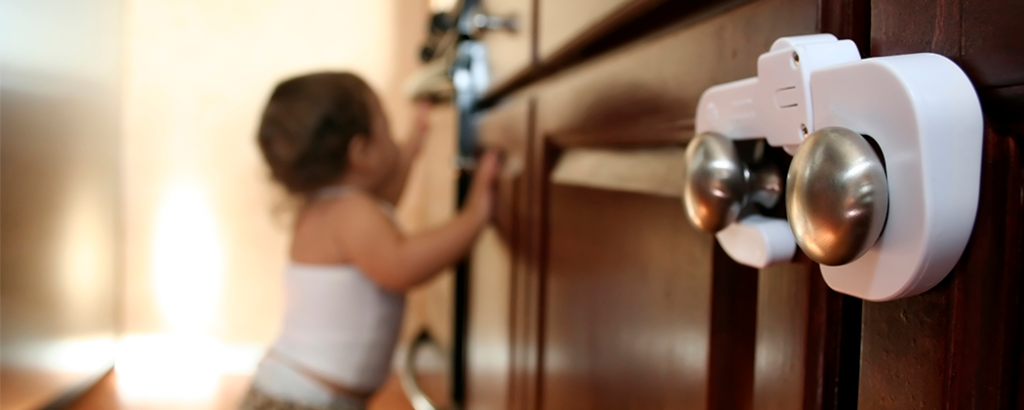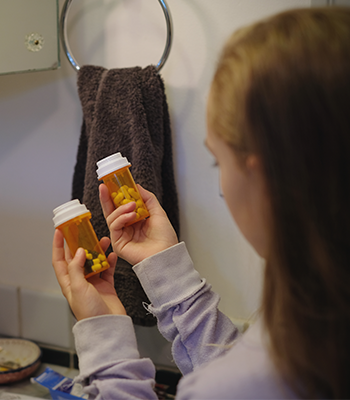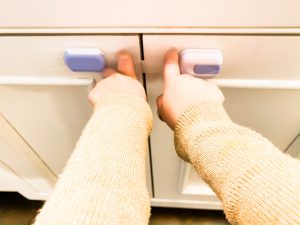
Home is a place where everyone deserves to feel safe. But did you know? Most childhood poisonings happen inside the home.
While most poisonings can be treated with advice from the poison control center or help from a medical professional, the safest bet is to prevent poisonings from ever happening. That’s why in honor of Poison Prevention Week, we’re sharing more about what you need to watch out for at home, and what you can do to ensure your child doesn’t eat or drink unsafe chemicals.
Save the number in your phone, with instructions for babysitters, and near areas where children play: 1-800-222-1222. Poison Centers are staffed with trained medical professionals who can offer free advice, and can often keep kids at home.
Are there harmful chemicals in my home?
Medications
According to leading injury prevention organization Prevent Child Injury, 9 out of every 10 poisonings in children under the age of 12 are from medications.
To little kids, medications may look like candy and peak their interest. Here’s a quiz from California Poison Control to show you just how similar candy can look to medications.
Medications are safe when taken as prescribed, but over-the-counter medications and prescriptions can be dangerous for kids if they take too much. If your older child or teen manages their own medications, be sure they understand the dose they should take. It’s important to monitor your child’s mood and behavior while they’re taking medication and ask your doctor if you have any concerns. Finally, understand the side effects of medications your children might take and monitor their activities accordingly.

Getting rid of medications
Getting rid of the unused or expired medications in one way to keep your home safe. The best (and safest!) way to do this is through medication take-back options. This means you return your unused or expired medications to a take-back location where the medications then are destroyed properly, according to the FDA.
Typically, your community will have plenty of take-back location options, and the FDA provides you different ways to find them:
- Find an authorized drug collection site near you.
- Call the DEA Diversion Control Division Registration Call Center at 1-800-882-9539 for more information about these collection sites.
- Go to Google MapsExternal Link Disclaimer and type in “drug disposal near me” or “medication disposal near me” to find your nearest drug disposal site.
These sites are simple to use and always free. Learn more about medication take-backs from the FDA.
Cleaning products and household chemicals
With the bright colors and sweet scents, young children may try to drink household chemicals and cleaning products. It’s also important to note that, according to KidsHealth, laundry and dishwasher pods are more dangerous as their appearance resembles candy or something sweet, so you may want to consider switching to a liquid or powder detergent and keep it out of reach.
Kids are also known to eat off the floor from time to time, so be sure not to use roach powder or rat poison on floors in your house.
Alcohol
Many parents enjoy alcoholic beverages from time to time, and while this may be safer for grown-ups, it can be harmful to little ones. Be sure to keep all alcohol out of kids’ reach, preferably in a locked cabinet. It’s also important to be mindful of baking supplies like vanilla extract, which may have enough alcohol to harm a child.
Lead paint
Items made before 1978, such as old cribs, high chairs or painted toys, may have a finish that contains lead. You can keep up with U.S. Consumer Product Safety Commission (CPSC) toy recalls online.
Liquid nicotine
Liquid nicotine is used in vaping devices and e-cigarettes. While this form of nicotine is dangerous when inhaled, it is especially toxic if spilled on the skin or ingested because you will end up with a higher concentration of the chemical in your body. Symptoms of nicotine poisoning can present just minutes after a spill and can include:
- Fast heartbeat.
- Jittery or unsteady appearance.
- Difficulty breathing.
- Increased saliva.
How can I prevent poisonings?
With more than 90% of poisonings occurring inside the home, it’s important to do what you can to prevent kids from getting into harmful chemicals.

Keep it out of reach
Kids like to copy adults, so never leave potential toxins, including alcohol, on kitchen tables, countertops, bedside tables or low shelves where kids can help themselves.
Lock it up
It’s convenient to keep cleaning chemicals like bleach, dish soap or dishwasher detergent under the sink, but it’s easy to for kids to reach. But you don’t have to find a new place to store these chemicals – simply lock or use a safety latch on the cabinet so children can’t get in on their own.
Resist repackaging
Never put cleaning products in old soda bottles or containers that were once used to store food. Kids can easily be confused about what is in the container and may drink it. It’s equally as important to keep medications in their original containers in case you ever need to refer back to the directions or dosage instructions.
What should I do if my child swallowed something harmful?
If you believe that your child swallowed or came in contact with something harmful, you can contact the poison control center for free and confidential help. You can get help online or by calling their 24/7 hotline at 1-800-222-1222.
In case of an emergency, always call 9-1-1 or bring your child to an emergency room.
Emergency care at Children’s Minnesota
We love kids. But we want to see them safe at home. However, we have a team of experts in trauma and emergency care that is always there to help your child every step of the way, no matter what happens.
Between our two emergency departments in St. Paul and Minneapolis, we care for more than 90,000 patients each year, meaning that we care for more pediatric emergency and trauma patients than any other health care system in the area. We are also home to the region’s only Level I pediatric trauma center in a hospital dedicated only to kids.